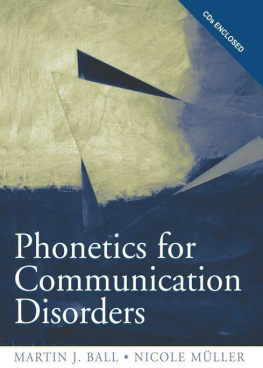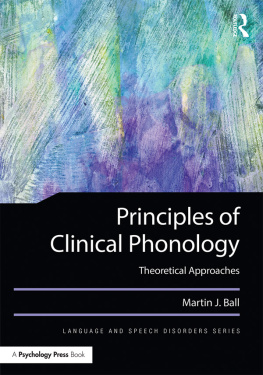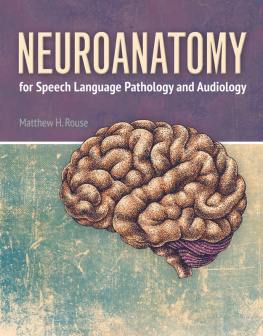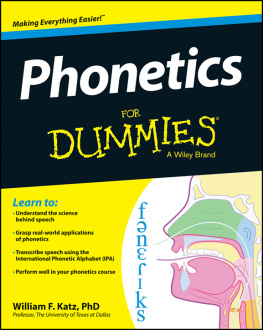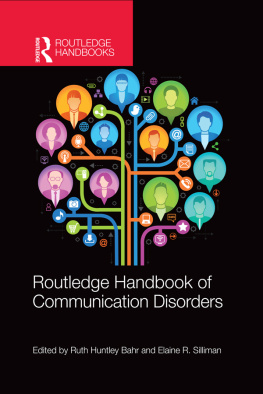Phonetics for Communication Disorders
PHONETICS FOR COMMUNICATION DISORDERS
by
Martin J. Ball & Nicole Mller
University of Louisiana at Lafayette
This edition published 2011 by Routledge
Routledge
Taylor & Francis Group
711 Third Avenue
New York, NY 10017 | Routledge
Taylor & Francis Group
27 Church Road, Hove
East Sussex BN3 2FA |
Copyright 2005 by Lawrence Erlbaum Associates
All right reserved. No part of this book may be reproduced in
any form, by photostat, microform, retrieval system, or any
other means, without prior written permission of the publisher.
Library of Congress Cataloging-in-Publication Data
Ball, Martin J. (Martin John)
Phonetics for communication disorders / by Martin J. Ball Nicole Mller.
p. cm.
Includes bibliographical references and index.
ISBN 0-8058-5363-4 (case : alk. paper)ISBN 0-8058-5364-2 (pbk.: alk. paper)
1. English language-Phonetics. 2. Speech disorders. I. Mller, Nicole, 1963- II. Title.
RC423.B2843 2005
Contents
Having taught phonetics to students in communication disorders programs for nearly 20 years, I have sampled a wide variety of textbooks in my time. Although there have been many excellent texts to choose from over the years, I am always pleased to come across new books that offer different approaches to the subject. Phonetics for Communication Disorders is an exciting addition to the array of choices. It contains all of the features that to me define a good phonetics text, including thorough and accurate content coverage, relevant and useful examples and illustrations, and a comprehensive set of exercises for transcription practice. But it also goes beyond the scope of many other texts, covering all aspects of general phonetics as well as English phonetics and clinical phonetics.
Teaching phonetic transcription to students with communication disorders is a challenge. Many of them have had limited exposure to languages other than English and find it difficult to perceive and transcribe non-English sounds. But as the authors point out in the preface, clients in the speech clinic often produce non-English sounds, and students need to learn to transcribe them. Whereas many other texts begin with, or restrict themselves, to the transcription of English sounds, Phonetics for Communication Disorders follows the premise that it is best to begin learning to transcribe both English and non-English sounds, thereby reducing the transcriber's tendency to filter what they hear through the expectations of their own linguistic system. For example, exercises on the accompanying audio CD begin with non-English and nonsense-word examples to sharpen listening skills, and only later move on to English words.
The organization of Phonetics for Communication Disorders provides an ideal structure for courses in phonetics geared to students of communication disorders. Part I provides a comprehensive introduction to phonetics, assuming no previous background on the topic. Integrating information from anatomy, physiology, articulation, acoustics, and perception, it leads the reader through the basics of speech productionairstream mechanisms, phonation, vowels, consonants, and prosody. This provides a context for part II, which focuses on the phonetic and phonological structure of English. Students are thus able to examine the speech sounds of their own language, English, from a broader perspective. Another unique feature of this book is its coverage of both British and American models of English; other phonetics texts focus on one or the other, making it difficult for speakers of the other variety of English to follow, especially when the examples provided do not match their own pronunciation. Recognizing that not all clients speak standard varieties of British or American English, part II also includes a description of other varieties of English. Finally, after a solid grounding in general phonetics and an understanding of the range of variation in typical English speech production, part III introduces phonetic and phonological descriptions of disordered speech and the transcription of atypical and disordered speech. Throughout the book, the latest research and models are incorporated, providing students with the benefits of information obtained from new technologies and theoretical models. Exercises from the text and the accompanying audio CD provide opportunities to apply newly learned transcription skills along the way.
The authors, Martin J. Ball and Nicole Mller, are perfectly suited to write this text, both having had extensive experience teaching phonetics in communication disorders programs in the UK and US. Ball was an influential member of the teams that developed the ExtlPA and VoQS symbols for the transcription of disordered speech in the late 80s and early 90s, and is well-known in the UK as the author of other linguistics textbooks, including a popular 1993 text on general phonetics. He also co-authored a 1996 text on phonetic transcription of disordered speech geared toward instructors of applied phonetics courses, which included excellent overviews of the history of phonetic transcription, including recent developments in the transcription of disordered speech, and a range of methods for training students in phonetic transcription. Many of these methods are integrated into the current text.
Finally, although Phonetics for Communication Disorders is intended for students in professional training programs, the thorough and current coverage of phonetics and transcription practices may also be of interest to practicing speech-language pathologists wanting to review or upgrade their skills. Those who use it will find themselves well prepared for the challenges of transcribing disordered speech.
Karen E. Pollock
University of Alberta
This book is about phonetics, the science of speech, and it has been designed specifically for students following communication disorders programs. It assumes no prior knowledge of the topic, and leads the reader from the basics of human spoken communication, through the mechanics of speech and the analysis of English pronunciation (concentrating on American and British standards, but also including other varieties of English), to the application of phonetics to the description and analysis of disordered speech. It also introduces phonetic transcription and, with the use of the accompanying audio CD, allows the reader to gain proficiency in the transcription of speech into phonetic symbolsa vital skill for clinicians. This text and CD, therefore, will act as a sourcebook for students throughout their undergraduate and graduate programs and in their careers as speech-language pathologists.
There are a few preliminary points we wish to make to aid the reader with the topic and with using the text. First, there are some authors who divide the study of speech, perhaps rather artificially, into phonetics (concerned mainly with the description of the articulation of speech sounds) and speech science (concerned mainly with aspects such as the anatomy and physiology of speech and the acoustic analysis of speech). Our account offers a more integrated approach, and therefore this book deals with all these aspects of speech, albeit with most emphasis on the production side. This book is deliberately maximal in its coverage. There is no benefit to the student in learning a dumbed-down version of phonetics; the very information you may need to understand the speech production of a particular client may well be missing in such an account. However, the professors teaching from this text may well wish to concentrate on specific aspects of a topic, leaving the student to read the entire chapter to gain further information.
Next page
